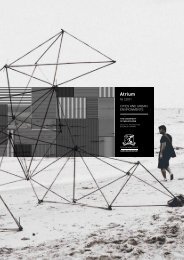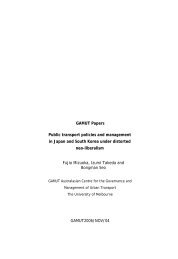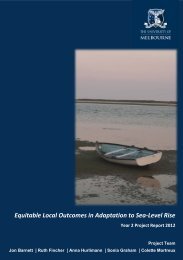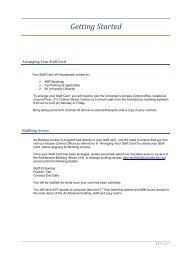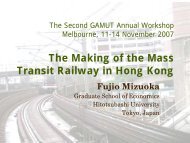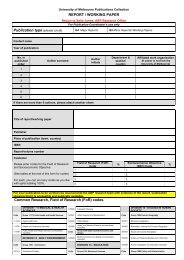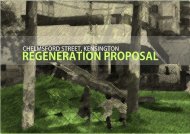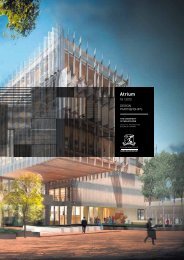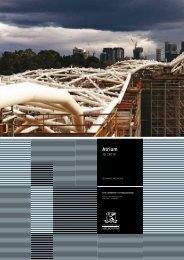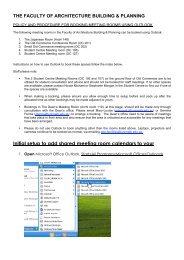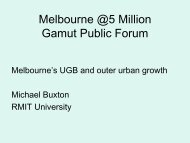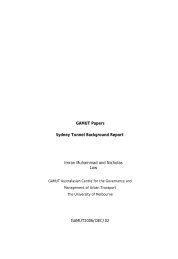May - Faculty of Architecture, Building and Planning - University of ...
May - Faculty of Architecture, Building and Planning - University of ...
May - Faculty of Architecture, Building and Planning - University of ...
You also want an ePaper? Increase the reach of your titles
YUMPU automatically turns print PDFs into web optimized ePapers that Google loves.
Fear Free CityJustyna Karakiewicz,Tom Kvan <strong>and</strong>Steve HatzellisMould CityPeter Raisbeck, Nicola Dovey<strong>and</strong> Simon Wollan(as part <strong>of</strong> Colony Collective)Michael Sorkin (in Local Code) assertsthat “…freedom, pleasure, convenience,beauty, commerce <strong>and</strong> production are thereasons for the city… participation in theseattributes is a fundamental civic right <strong>and</strong>must ever be refined through the filter <strong>of</strong>consent”. Why is it we escape the freedom<strong>of</strong> the city <strong>and</strong> head for the suburbs whereour families become prisoners <strong>of</strong> ourdreams, isolated by the car fromcommunity involvement into zones<strong>of</strong> privatization <strong>and</strong> disengagement?From the popular press, you mightconclude that we fear the city, its crime<strong>and</strong> antisocial behavior. In search <strong>of</strong> safe<strong>and</strong> affordable living, we flee, movingfurther from the centre, thus spendingmuch <strong>of</strong> our free time commuting. Wesearch for space, but we end up witha tiny hardscape garden barely enoughfor a barbeque <strong>and</strong> a few potted plants.We fear climate change, knowing that thislifestyle is unsustainable without drasticrevision. We shower more efficiently,compete with our neighbors by reducingwater consumption to a minimum, <strong>and</strong>watch our precious garden die. We knowthat this is not enough so we blamegovernment (or the rest <strong>of</strong> the world);we all carry on in fear <strong>of</strong> the future. Eachday we open the P<strong>and</strong>ora’s box in whichsomeone has forgotten to put hope.This project seeks to flush away fear<strong>and</strong> reveal the many opportunities for arewarding, sustainable city. The proposalstarts with NOW: 7 Desperate Dreamsfollowed by THEN: 7 Desiring Dreams,which lead us to develop the foundationwhere dreams become reality in theFEAR FREE CITY. AMould City is an urban system whichreconfigures the relationship betweenhumans <strong>and</strong> shelter. In 2050 Australiansuburbs <strong>and</strong> cities will require a newenergy system which will require a newlanguage <strong>of</strong> urbanism. Mould Cityproposes that the garl<strong>and</strong>s <strong>of</strong> the Vitruvianprimitive hut have been given a new life<strong>of</strong> the physicality <strong>of</strong> inanimate materials.Mould City is a response to the currenturban situation. A situation in which carbonproduction is choking the earth’s cities<strong>and</strong> suburbs. In response to this situation,Mould City reconsiders the Australiansuburbs <strong>and</strong> city <strong>of</strong> 2050 as a family <strong>of</strong>sensual experiences which reverberatewith the seasons, the moon <strong>and</strong> the sun.Mould is an integrated, interacting systems<strong>of</strong> environs. The mould is introduced on theoutskirts <strong>of</strong> the suburbs. It was designed togrow in the new environment on thesuburbs existing infrastructure. Mouldcolonies form <strong>and</strong> reform. Along withshelter, the mould provides food. As words,mould urbanism evokes both the intricacies<strong>of</strong> slime mould <strong>and</strong> those vessels whichgive form to plastic material. The mouldgrows across over <strong>and</strong> through the oldinfrastructure <strong>of</strong> the city. The mould isan urban architecture which needs directsolar energy. It changes <strong>and</strong> respondsto the sun’s orientation during the seasons.It waxes <strong>and</strong> wanes with the moon.It spreads across the suburbs <strong>and</strong>is sensitive to the energy levels <strong>of</strong> itsinhabitants. It is like a foam that aeratesitself when happiness abounds. Poreswill form in the mould so it can breathe.Water vessels <strong>and</strong> reservoirs will formin the mould both as heat sinks<strong>and</strong> as replenishment. Mould factorieswill produce new products. The mouldwill adapt to the seasonal <strong>and</strong> diurnalcycles <strong>of</strong> its inhabitants. It will be thesetting for new rituals <strong>and</strong> harvest festivals.The architecture <strong>of</strong> the mould allows a newrealm <strong>of</strong> sensual experiences to come intoplay for its inhabitants. Smell, sight touch<strong>and</strong> taste <strong>and</strong> thermal experiences areall. The mould is a living organism <strong>of</strong> thecommunity nursed by the sun. It nurtureslife <strong>and</strong> <strong>of</strong>fers protection to all within itsrealm. The mould helps its inhabitants torelease new energies which reverberatewithin it. This promotes bio developmentinstead <strong>of</strong> techno degeneration. MouldCity bridges the gulf that divides anurbanism based on digital diatoms fromone based on radical community politics.Colony is a collective <strong>of</strong> architects whoproduce utopian vision in response totoday’s climate crisis. Our inspiration isthe architecture <strong>of</strong> the 60s mashed withthe suburbs <strong>of</strong> Corrigan. Our inspirationis Yona Friedman, Archigram, Superstudio<strong>and</strong> Archizoom. A



